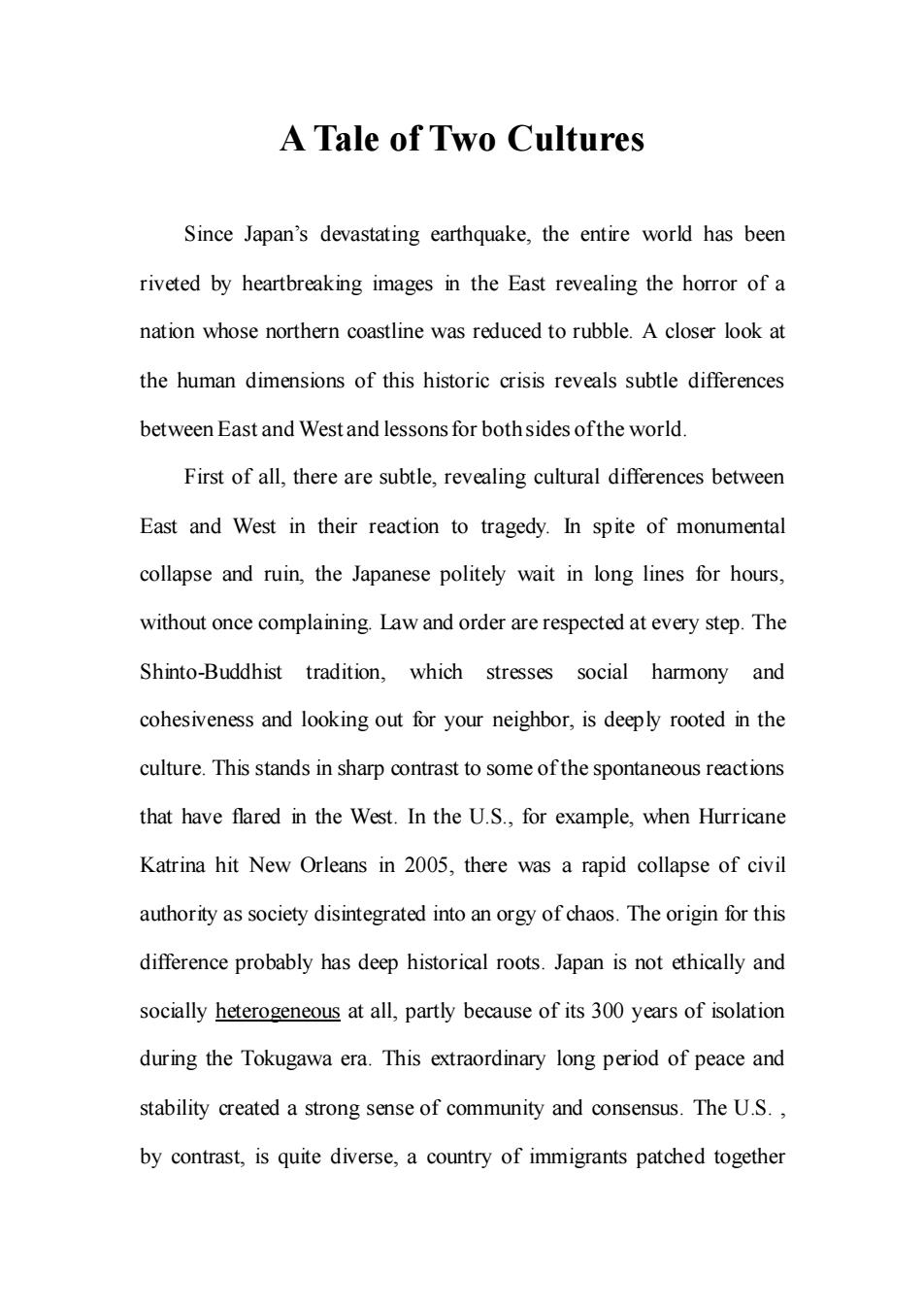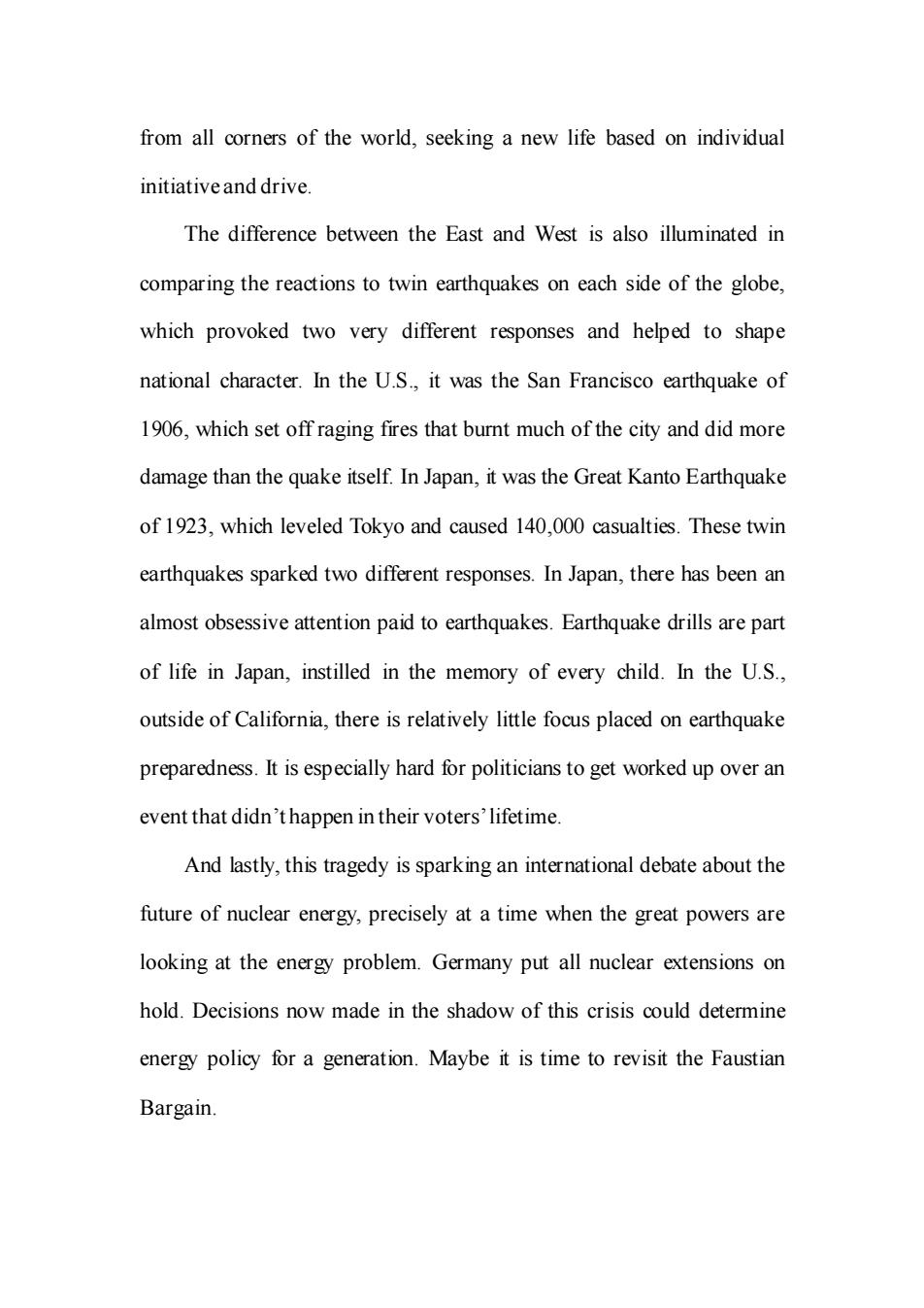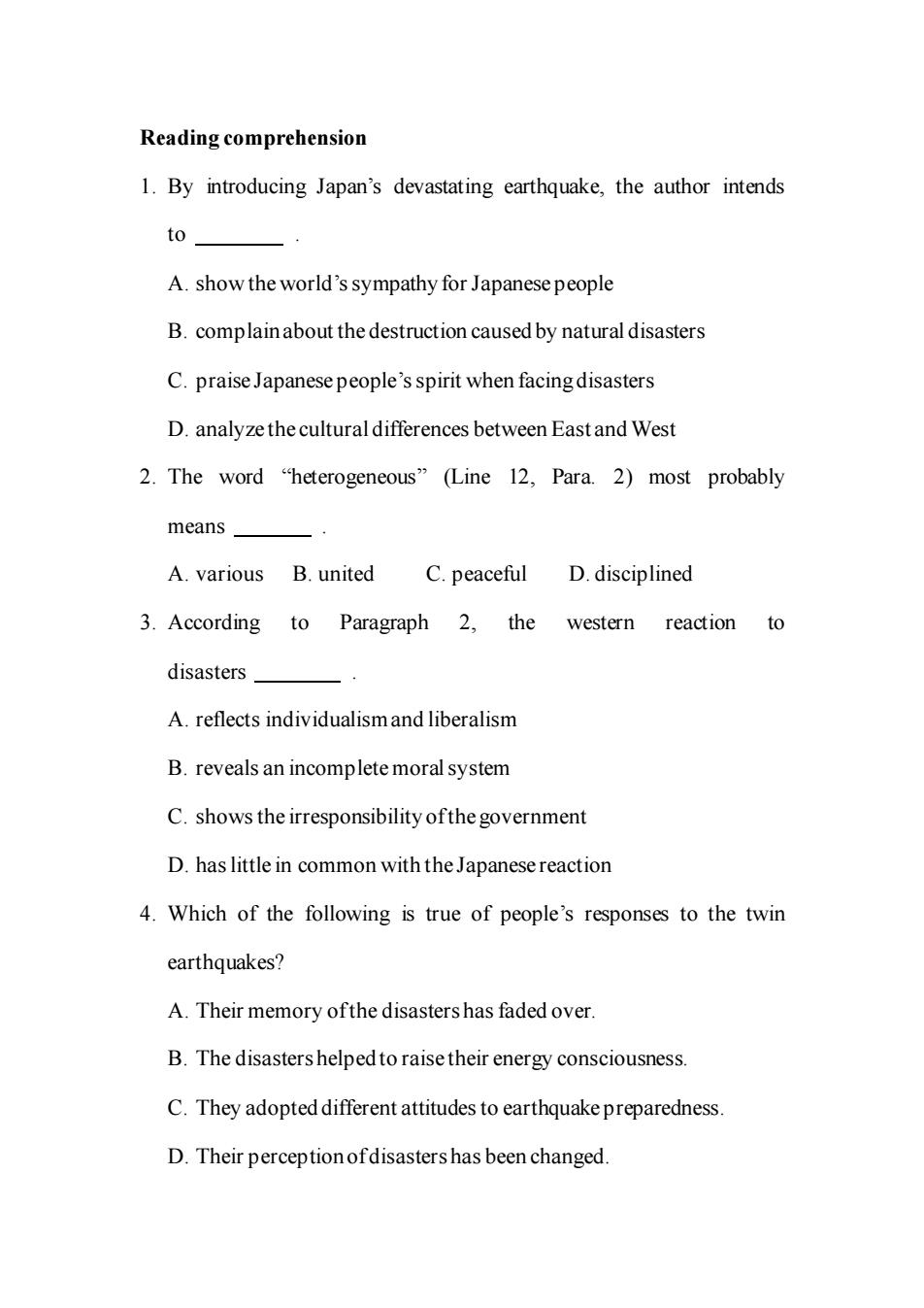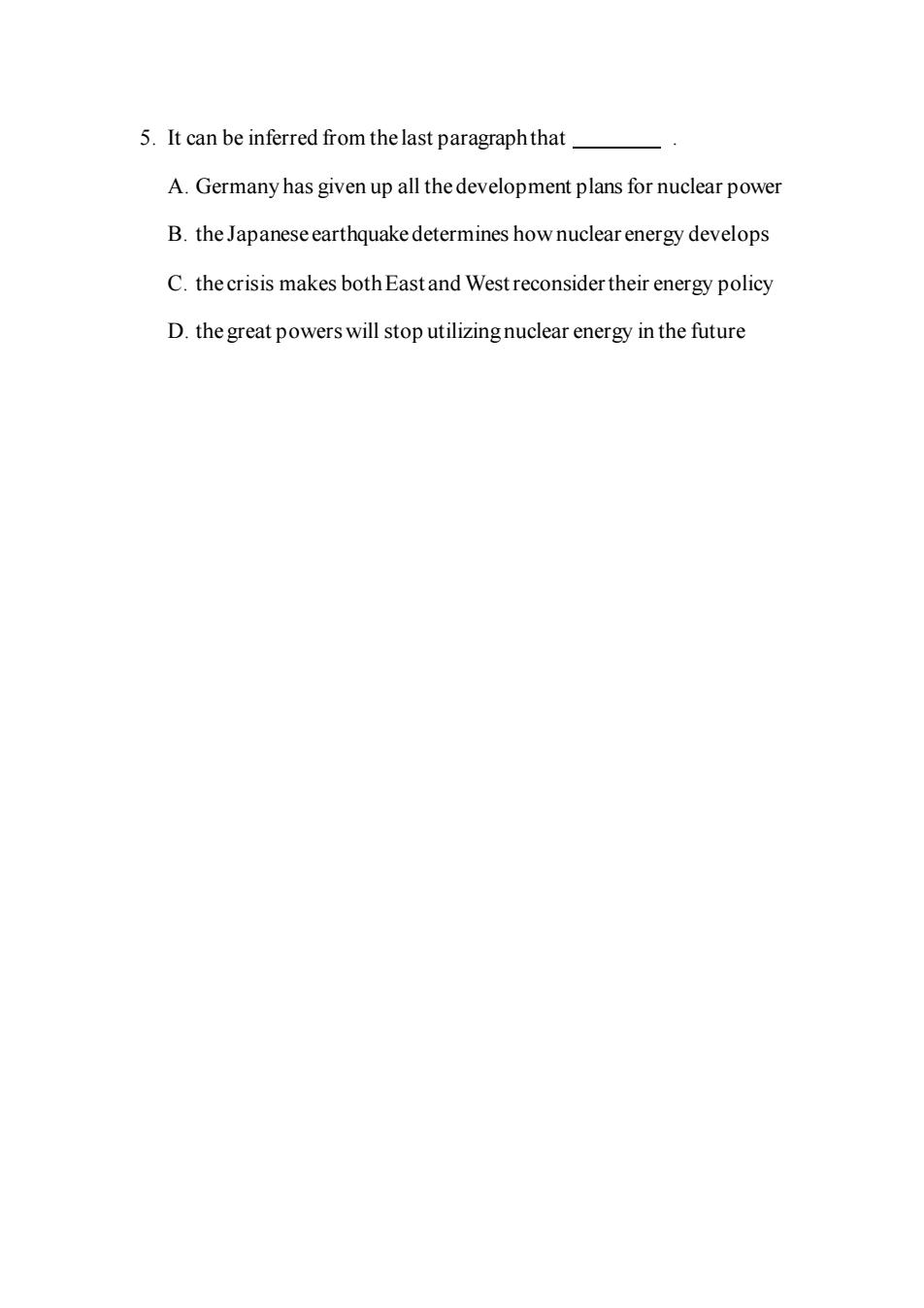
A Tale of Two Cultures Since Japan's devastating earthquake,the entire world has been riveted by heartbreaking images in the East revealing the horror of a nation whose northern coastline was reduced to rubble.A closer look at the human dimensions of this historic crisis reveals subtle differences between East and West and lessons for bothsides ofthe world First of all,there are subtle,revealing cultural differences between East and West in their reaction to tragedy.In spite of monumental collapse and ruin,the Japanese politely wait in long lines for hours, without once complaining.Law and order are respected at every step.The Shinto-Buddhist tradition,which stresses social harmony and cohesiveness and looking out for your neighbor,is deeply rooted in the culture.This stands in sharp contrast to some ofthe spontaneous reactions that have flared in the West.In the U.S.,for example,when Hurricane Katrina hit New Orleans in 2005,there was a rapid collapse of civil authority as society disintegrated into an orgy of chaos.The origin for this difference probably has deep historical roots.Japan is not ethically and socially heterogeneous at all,partly because of its 300 years of isolation during the Tokugawa era.This extraordinary long period of peace and stability created a strong sense of community and consensus.The U.S., by contrast,is quite diverse,a country of immigrants patched together
A Tale of Two Cultures Since Japan’s devastating earthquake, the entire world has been riveted by heartbreaking images in the East revealing the horror of a nation whose northern coastline was reduced to rubble. A closer look at the human dimensions of this historic crisis reveals subtle differences between East and West and lessons for both sides of the world. First of all, there are subtle, revealing cultural differences between East and West in their reaction to tragedy. In spite of monumental collapse and ruin, the Japanese politely wait in long lines for hours, without once complaining. Law and order are respected at every step. The Shinto-Buddhist tradition, which stresses social harmony and cohesiveness and looking out for your neighbor, is deeply rooted in the culture. This stands in sharp contrast to some of the spontaneous reactions that have flared in the West. In the U.S., for example, when Hurricane Katrina hit New Orleans in 2005, there was a rapid collapse of civil authority as society disintegrated into an orgy of chaos. The origin for this difference probably has deep historical roots. Japan is not ethically and socially heterogeneous at all, partly because of its 300 years of isolation during the Tokugawa era. This extraordinary long period of peace and stability created a strong sense of community and consensus. The U.S. , by contrast, is quite diverse, a country of immigrants patched together

from all corners of the world,seeking a new life based on individual initiative and drive. The difference between the East and West is also illuminated in comparing the reactions to twin earthquakes on each side of the globe, which provoked two very different responses and helped to shape national character.In the U.S.,it was the San Francisco earthquake of 1906,which set off raging fires that burnt much of the city and did more damage than the quake itself.In Japan,it was the Great Kanto Earthquake of 1923,which leveled Tokyo and caused 140,000 casualties.These twin earthquakes sparked two different responses.In Japan,there has been an almost obsessive attention paid to earthquakes.Earthquake drills are part of life in Japan,instilled in the memory of every child.In the U.S., outside of California,there is relatively little focus placed on earthquake preparedness.It is especially hard for politicians to get worked up over an event that didn'thappen in their voters'lifetime. And lastly,this tragedy is sparking an international debate about the future of nuclear energy,precisely at a time when the great powers are looking at the energy problem.Germany put all nuclear extensions on hold.Decisions now made in the shadow of this crisis could determine energy policy for a generation.Maybe it is time to revisit the Faustian Bargain
from all corners of the world, seeking a new life based on individual initiative and drive. The difference between the East and West is also illuminated in comparing the reactions to twin earthquakes on each side of the globe, which provoked two very different responses and helped to shape national character. In the U.S., it was the San Francisco earthquake of 1906, which set off raging fires that burnt much of the city and did more damage than the quake itself. In Japan, it was the Great Kanto Earthquake of 1923, which leveled Tokyo and caused 140,000 casualties. These twin earthquakes sparked two different responses. In Japan, there has been an almost obsessive attention paid to earthquakes. Earthquake drills are part of life in Japan, instilled in the memory of every child. In the U.S., outside of California, there is relatively little focus placed on earthquake preparedness. It is especially hard for politicians to get worked up over an event that didn’t happen in their voters’lifetime. And lastly, this tragedy is sparking an international debate about the future of nuclear energy, precisely at a time when the great powers are looking at the energy problem. Germany put all nuclear extensions on hold. Decisions now made in the shadow of this crisis could determine energy policy for a generation. Maybe it is time to revisit the Faustian Bargain

Reading comprehension 1.By introducing Japan's devastating earthquake,the author intends to A.show the world's sympathy for Japanese people B.complainabout the destruction caused by natural disasters C.praise Japanese people's spirit when facingdisasters D.analyze the cultural differences between East and West 2.The word "heterogeneous"(Line 12,Para.2)most probably means A.various B.united C.peaceful D.disciplined 3.According to Paragraph 2,the western reaction to disasters_ A.reflects individualism and liberalism B.reveals an incomplete moral system C.shows the irresponsibility ofthe government D.has little in common withthe Japanesereaction 4.Which of the following is true of people's responses to the twin earthquakes? A.Their memory ofthe disasters has faded over. B.The disastershelpedto raisetheir energy consciousness. C.They adopted different attitudes to earthquake preparedness. D.Their perceptionofdisasters has been changed
Reading comprehension 1. By introducing Japan’s devastating earthquake, the author intends to . A. show the world’s sympathy for Japanese people B. complain about the destruction caused by natural disasters C. praise Japanese people’s spirit when facing disasters D. analyze the cultural differences between East and West 2. The word “heterogeneous” (Line 12, Para. 2) most probably means . A. various B. united C. peaceful D. disciplined 3. According to Paragraph 2, the western reaction to disasters . A. reflects individualism and liberalism B. reveals an incomplete moral system C. shows the irresponsibility of the government D. has little in common with the Japanese reaction 4. Which of the following is true of people’s responses to the twin earthquakes? A. Their memory of the disasters has faded over. B. The disasters helped to raise their energy consciousness. C. They adopted different attitudes to earthquake preparedness. D. Their perception of disasters has been changed

5.It can be inferred from the last paragraphthat A.Germany has given up all the development plans for nuclear power B.the Japaneseearthquake determines how nuclear energy develops C.thecrisis makes both East and West reconsider their energy policy D.the great powers will stop utilizingnuclear energy in the future
5. It can be inferred from the last paragraph that . A. Germany has given up all the development plans for nuclear power B. the Japanese earthquake determines how nuclear energy develops C. the crisis makes both East and West reconsider their energy policy D. the great powers will stop utilizing nuclear energy in the future